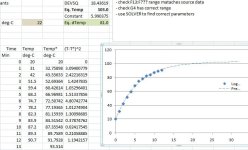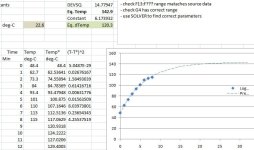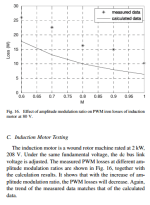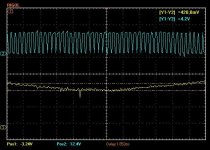Treid 8 kHz, 12 deg timing. Same speed, same load.
- Motor equilibrium temp was unchanged.
- ESC equilibrium temp was down a few degrees, but really in the noise of the experiment data accuracy.
Tried 16 kHz, 12 deg timing. Same speed, same load.
- Motor equilibrium temp was way down, now at ~85 deg-C above ambient (down from > +100 deg-C above ambient)
- ESC equlibrium temp was, +59 deg-C above ambient. (down from +79 deg-C for 0-deg timing)
Summary:
- too low timing significantly adversely affected both the motor and ESC waste heat at higher PWM frequency
- higher PWM frequency still appears to result in higher motor (~5-10 deg-C) and ESC (~20 deg-C) temperatures .
- ESC had more trouble starting against the dyno load from stand still at 12 deg timing, compared to 0 deg timing.
- higher ESC temp coincides with high motor temp, for cases where timing does not appear to be advanced enough, when comparing similar runs with different temperature rises.
Here is a screen dump of the summary data.
Note:
- Eq Temp* = Predicited thermal equilibrium temperature
dTemp = temperature above ambient
Fin.T = final motor temperature before test halted (note equilibrium temperature are extrapolated beyond this to predict equilibrium)
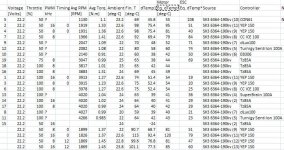 Highlights:
Highlights:
- synchronous rectification really helps ESC temps at partial throttle
- YEP 150 performed thermally better than an EB306 at partial throttle, even with essentailly no heat sink, verses the ebike controllers huge aluminium case
- full throttle temps are not an issue for any of the controllers
And here is the text of the data:
Code:
Voltage Throttle PWM Timing Avg RPM Avg Torq. Ambient Fin. T dTemp1 Eq. dTemp* Eq. dTemp* Source Controller
[Volts] [%] kHz [RPM] [N.m] [deg-C] [deg-C] [deg-C]
22.2 50 ? 1130 1.1 23.2 69 45.8 55 108 SK3 6364-190kv (10) CON61
22.2 50 16 0 1919 1.33 22.6 98 75.4 95 51 SK3 6364-190kv (11) YEP 150
22.2 50 8 0 1931 1.36 22.6 98 75.4 81 40 SK3 6364-190kv (9) YEP 150
22.2 50 8 1966 1.41 22.6 92 69.4 79 84 SK3 6364-190kv (8) CC ICE 100
22.2 50 ? 2047 1.09 22 70 48 52 71 SK3 6364-190kv (7) dLux100
22.2 50 ? 2082 1.08 22 80 58 60 74 SK3 6364-190kv (5) Turnigy Sentilon 100A
22.2 50 ? 2140 0.91 22 60 38 42 50 SK3 6364-190kv (6) EB306
22.2 75 8 3047 0.99 25 63 38 44 69 SK3 6364-190kv Tz85A
22.2 100 8 3817 1.01 23 65 42 44 SK3 6364-190kv Tz85A
22.2 100 8 3883 1.31 24 69 45 49 SK3 6364-190kv Tz85A
22.2 100 16 0 3913 1.27 22.6 74 51.4 54 19 SK3 6364-190kv (11) YEP 150
22.2 100 8 0 3915 1.23 22.6 75 52.4 54 20 SK3 6364-190kv (9) YEP 150
22.2 100 8 3978 1.27 22.6 75 52.4 54 25 SK3 6364-190kv (8) CC ICE 100
22.2 100 ? 4020 1.04 24 63 39 41 36 SK3 6364-190kv (4) SuperBrain 100A
22.2 100 16 4020 1.02 24 64 40 41 29 SK3 6364-190kv (2) Tz85A
22.2 100 8 4020 0.99 24 64 40 42 29 SK3 6364-190kv Tz85A
22.2 100 ? 4027 0.99 20 59 39 40 21 SK3 6364-190kv (7) dLux100
22.2 100 ? 4266 0.985 22 64 42 43 23 SK3 6364-190kv (5) Turnigy Sentilon 100A
22.2 50 16 24 -24 SK3 6364-190kv (2) Tz85A
22.2 50 8 0 1899 1.37 22 90.7 68.7 81 51 SK3 6364-190kv (9) YEP 150
22.2 50 16 0 1826 1.37 22.6 115 92.4 120 79 SK3 6364-190kv (11) YEP 150
22.2 50 8 12 1869 1.45 22.8 99.6 76.8 81 47 SK3 6364-190kv (12) YEP 150
22.2 50 16 12 1869 1.45 23.8 101.1 77.3 85 60 SK3 6364-190kv (13) YEP 150
